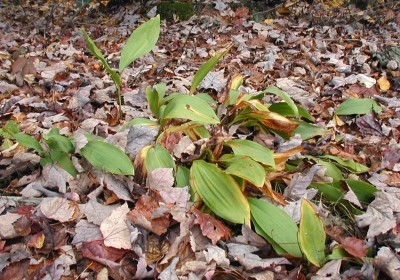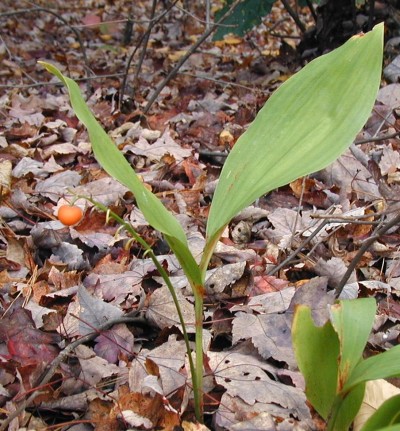Saw something the other day that I had never seen before…a fruiting Lily of the Valley! We’ve had Lily-of-the-Valley growing at the edge of the lane for a couple of years now. A neighbor gave away a large clump of it when they were changing their landscaping.
I was happy to see that the Lily-of-the-Valley grew well enough in our poor soil to multiply. It fills me with excitement and joy to see the Lily-of-the-Valley growing in such poor soil. We have clay and rocks for soil here up on the mountain ridge. Any planting we do is prefaced with amending the soil with spagnum moss, compost or any other soil I can get my hands on.
When planting the Lily-of-the-Valley the first year I split the large plant into two clumps. The second year the clumps were larger and had more of the linear foliage. This year new plants popped up about 2-3 feet from the original plants, probably by runners as the new plants appeared in the direction that the original plant was spreading.

Lily-of-the-Valley spreading out by runners from the original plant. Photo taken 16OCT08.
Leaves of Lily-of-the-Valley have parallel veins, which is a characteristic showing that is it a monocot, kind of like very large blades of grass. Each plant has two leaves and next to those two leaves arises a singular flower stalk.
The flowers dangle from the arching flower stalk. If you can get close enough to the flowers breathe deeply – their sweet scent is delicious. Expect it to flower from early to late May, at least that’s when Lily of the Valley blooms here in Central Pennsylvania.

Arching stems of white sweet flowers of Lily-of-the-Valley. Photo taken 6MAY06.
The blossoms last for a long week, perhaps two weeks or more until the flowers fade to brown and fall off the stem. A few stems are always clipped off and placed in a small glass of water so we can enjoy the sweet scent indoors.
A couple of weeks ago I noted that a single flower had been fertilized and produced a mature fruit. The fruit looked like a miniature pumpkin, fairly round and bright orange.

Orange fruit of Lily-of-the-Valley on the arching flower stalk. Photo taken 16OCT08.
Perhaps the plant had fruited before and I never noticed. I presumed it multiplied mostly by runners as I had seen evidence of that already. I never looked for fruit on it before, but you know I will again next year.
Have you seen Lily-of-the-Valley producing miniature pumpkin fruit like this?
Yes I was surprised to see the orange fruit as well. What is the purpose for the fruit? What is the next step in the process of plant maturity?
Hey Kristin,
This year I didn’t see any orange fruits on our Lily-of-the-Valley. It was a very hot and dry summer in PA so lots of plants didn’t grow their best.
The fruit will most likely be eaten by a midnight opossum or bunny rabbit or bird and they in turn will spread the seed with a little fertilizer at their next pit stop.
Many plants will have more than one way to spread themselves via runners, bulbs or seeds. We have another patch of Lily-of-the-Valley that started right underneath a Shepard’s Hook that we hang suet cakes from. Birds will stop there even if there’s no suet as it’s a high spot in the yard for them to look about the place. When one of the birds pooped it must have dropped a little package of processed orange fruit and a seed grew to eventually give a new patch of Lily-of-the-Valley. 🙂
Have your Lily-of-the-Valley grown out into more plants than what you started with?